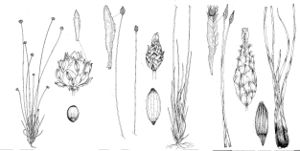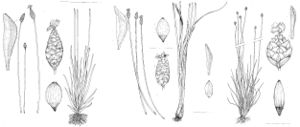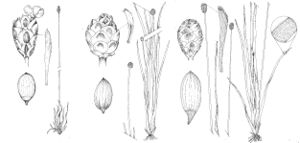Xyris
Sp. Pl. 1: 42. 1753; Gen. Pl. ed. 5; 25, 1754.
Herbs, perennial, occasionally annual, rosulate. Stems simple, erect, sometimes caudiciform, short to branching, elongate. Leaves alternate, 2-ranked, equitant; blade mostly linear to filiform, flattened to nearly terete, margins smooth to variously papillate or scabrous. Inflorescences: scapes variously elongate; spike bracts imbricate, the proximal sterile, decussate, distal ones fertile, in spiral [decussate], bearing medially, usually subapically, a distinct and mostly differently textured and colored dorsal area or this indistinct or absent. Flowers solitary in bract-axils; sepals 3, distinct, unequal, lateral (outer) sepals distinct [connate], chaffy, boatshaped, chaffy, inner one membranous, capping corolla; keel papery, or scarious, variously winged, variously margined; petals 3, distinct [to connate], equal, strongly clawed; blade ephemeral, spreading, yellow to white; staminodes 3, distinct, strongly clawed, apically yoked, bearded with moniliform hairs (rarely reduced, beardless); stamens 3, epipetalous; anthers 2–4-locular; ovaries y thin-walled, placentation marginal to parietal [basal, free-central, axile]; styles elongate, tubular, 3-branched; stigmas 3, U-shaped or funnelform. Capsules 3-valved, usually thin, loculicidal. Seeds [1–] 15–90 or more, mealy or translucent, ovoid to cylindric, 0.3–1 (–4) mm, variously lined and cross-lined; endosperm starchy and proteinaceous; embryo basal-lateral, minute. x = 9.
Distribution
North America, West Indies, Central America, South America, Asia, Africa, South Pacific Islands
Discussion
Most species of Xyris occur in the Guiana Highlands, Amazonia, and Brazilia in South America, with other smaller centers of endemism in Africa and Australasia.
The key below is constructed to work with healthy plants that are in flower and/or fruit. Identifications based on sterile material are doubtful at best, then attempted only after long experience with such plants.
In the descriptions, scapes are described as linear if, 1 cm below the spike, they are 1 mm or more wide, or as filiform if, at that level, they are less than 1 mm wide. Petal color is assumed to be yellow, although X. caroliniana and X. platylepis have white-petaled forms. Leaf widths or thicknesses are measured at widest or thickest part of blade. Spike measurements are taken from mature spikes, those having at least some ripe fruit.
Species more than 250 (21 in the flora).
Selected References
Lower Taxa
Key
| 1 | Keel of lateral sepals usually firm, papillate, ciliate, ciliolate, or fimbriate, or in various combinations of these. | > 2 |
| 1 | Keel of lateral sepals scarious, lacerate to (rarely) nearly entire. | > 11 |
| 2 | Plants mostly under 30 cm, annual or perennial; scapes narrowly linear; scape sheaths mostly equaling or exceeding principal leaves; keels of lateral sepals papillate or ciliate; seeds 0.3–0.5 mm. | > 3 |
| 2 | Plants usually over 30 cm, perennial; scapes linear; scape sheaths exceeded by leaves; keels of lateral sepals ciliate, long-fimbriate, or lacerate; seeds 0.5 mm or longer. | > 5 |
| 3 | Margins of fertile bracts scarious, lacerate, often squarrose with red inner band; spikes mostly as broad as long; lateral sepal keel reddish apically; plants annual. | Xyris brevifolia |
| 3 | Margins of fertile bracts entire or erose; spikes mostly longer than broad; lateral sepal keel not reddish apically, concolorous; plants annual or perennial. | > 4 |
| 4 | Base of leaf sheaths with distinct chestnut brown patch; leaf blades olive green; plants perennial. | Xyris drummondii |
| 4 | Base of leaf sheaths without chestnut brown patch; leaf blades strongly maroon-tinged; plants annual. | Xyris flabelliformis |
| 5 | Lateral sepal tips exserted even on closed spikes; lateral sepal keels fimbriate or lacero-fimbriate. | > 6 |
| 5 | Lateral sepal tips included; lateral sepal keels ciliate. | > 8 |
| 6 | Lateral sepal keel apex lacero-fimbriate; fertile bracts with scarious, lacerate, often squarrose borders; seeds mostly 0.5–0.6 mm | Xyris elliottii |
| 6 | Lateral sepal keel apex distinctly long-fimbriate; fertile bracts entire to erose; seeds 0.7–1 mm. | > 7 |
| 7 | Plant base deeply set; leaf base chestnut brown; spikes ellipsoid to lanceoloid or cylindric, acute; leaves not in fans, narrowly linear, twisted, fleshy; sepal fimbriae red; scape ribs smooth or somewhat scabrous.5 | Xyris caroliniana |
| 7 | Plant base shallowly set; leaf base dull, straw-colored, green, or pinkish; spikes ovoid to ellipsoid, blunt; leaves in fans, broadly linear, slightly twisted, flat; sepal fimbriae pale; scape ribs harsh. | Xyris fimbriata |
| 8 | Leaves in fans; blade flat or slightly twisted. | > 9 |
| 8 | Leaves erect or ascending; blade twisted. | > 10 |
| 9 | Seeds mealy; leaf base maroon; leaf blade deep green with strong maroon tints; petal blade obtriangular, 3–4 mm | Xyris stricta |
| 9 | Seeds translucent; leaf base tan, straw-colored, or pale pink, but not maroon; leaf blade usually pale or olive green; petal blade obovate, 10 mm.0 mm | Xyris ambigua |
| 10 | Plant base abruptly bulbous; leaf blade elongate-linear, 2–5 mm wide. | Xyris torta |
| 10 | Plant base not abruptly bulbous; leaf blade narrowly linear to filiform, to 1 mm wide | Xyris isoetifolia |
| 11 | Leaf sheaths or sheath base light green, straw-colored, or dull brown. | > 12 |
| 11 | Leaf sheaths or sheath base with red, pink, or purple tints, or glossy brown or red-brown. | > 13 |
| 12 | Plants annual; leaves smooth; seeds translucent; scape ribs papillate.ate | Xyris jupicai |
| 12 | Plants perennial; leaves papillate to rugose, minutely scabrous; seeds mealy; scape ribs minutely scabrous | Xyris serotina |
| 13 | Leaf sheaths firm, glossy red-brown to tan. | > 14 |
| 13 | Leaf sheaths soft, pink, purple, or red. | > 15 |
| 14 | Staminodes beardless; seeds fusiform to cylindric, (0.7–)0.8–1 mm; leaf blade rarely to 1 mm wide. | Xyris baldwiniana |
| 14 | Staminodes bearded; seeds ellipsoid, 0.5–0.6 mm; leaf blade rarely less than 1 mm wide. | Xyris elliottii |
| 15 | Tips of lateral sepals exserted. | > 16 |
| 15 | Tips of lateral sepals included. | > 18 |
| 16 | Apex of Llateral sepals apex firm, red; seeds narrowly ellipsoid, 0.7–0.9 mm; leaf sheaths papillate. | Xyris montana |
| 16 | Apex of Llateral sepals apex thin, not red; seeds ellipsoid, 0.4–0.8 mm; leaf sheaths smooth. | > 17 |
| 17 | Leaf blade 1–2(–3) mm wide; spikes 10–16 mm; fertile bracts 4–6 mm; seeds 0.4–0.6 mm. | Xyris longisepala |
| 17 | Leaf blade 5–15 mm wide; spikes 10–20(–25) mm; fertile bracts 5–8 mm; seeds (0.6–)0.7(–0.8) mm | Xyris smalliana |
| 18 | Seeds opaque or mealy. | > 19 |
| 18 | Seeds translucent or mealy. | > 21 |
| 19 | Base of mature plant bulbous | Xyris tennesseensis |
| 19 | Base of mature plant not bulbous. | > 20 |
| 20 | Leaf blade smooth, at least 10 mm wide; scape distally with 1–2 smooth ribs | Xyris laxifolia var. iridifolia |
| 20 | Leaf blade papillate or somewhat scabrous, under 7 mm wide; scape distally with 3 or more somewhat scabrous ribs. | Xyris difformis |
| 21 | Base of plant not bulbous; leaves in fans; plants flowering in morning | Xyris difformis |
| 21 | Base of plant bulbous or nearly bulbous; principal leaves erect or ascending; plants flowering midday to afternoon. | > 22 |
| 22 | Seeds 0.5–0.6 mm | Xyris platylepis |
| 22 | Seeds 0.6–1 mm | Xyris scabrifolia |
"thin" is not a number.


